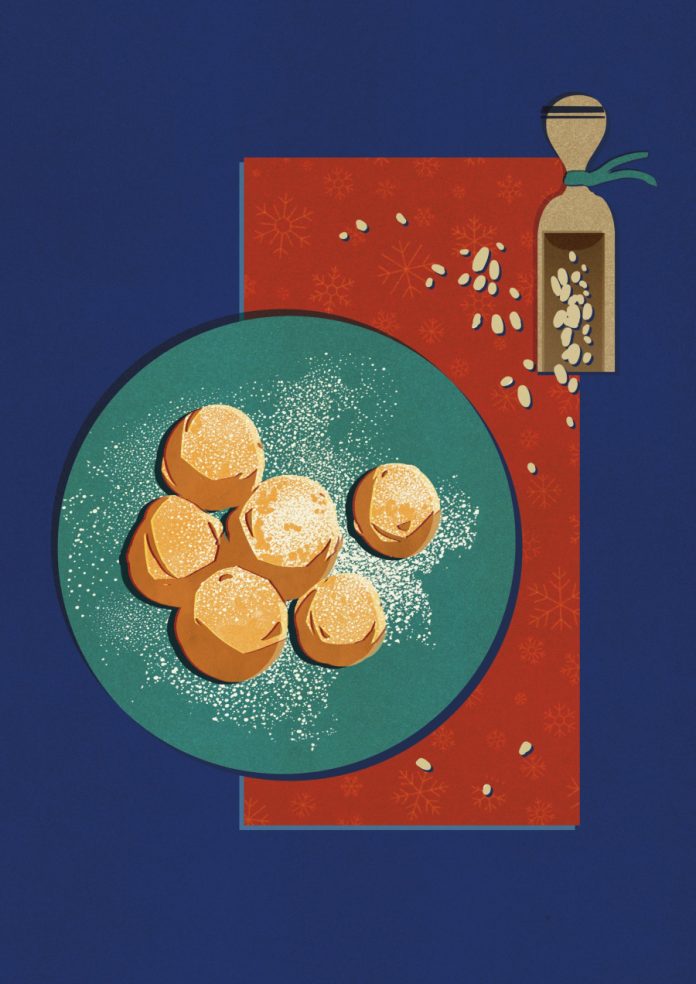Words: Theodora Negrea
Illustration: Sofi Deyneka
It’s the beginning of the year, and if you’ve been walking around Trieste, you’ve surely spotted the frittole: a fluffy small donut that nowadays comes in different variations. Each pasticceria will have its own slightly adjusted recipe, and Triestini will go to great lengths to make sure they get their favourite supply this season.
In Trieste, they are known as frittole, but you can find them across the Veneto region in the equally delicious form of frittelle, a culinary companion of the Carnevale season. According to some sources, their origin dates back to the Roman times, yet did you know that variations of these small delicious donuts are to be found across different cultures, in Europe and beyond? In fact, a number of countries have their own versions of fried or boiled dough made around the end of the year, while some are available all year long.
Condé Nast Traveler back in 2013 dedicated an entire article to these delicious dough-based desserts, and one thing is for sure: dough desserts are a deliciously decadent snack across cultures, especially when the weather gets cold and rainy. Let’s …dig in!
The Dutch ‘Oliebollen”. Around New Year’s Eve, but in reality as early as mid-October, cities across The Netherlands see the appearance of the Olieballen stands, mobile kiosks selling fried or baked desserts that are said to match well with a fizzy alcoholic drink. The hero of the season is the oliebol, a dense (and quite big) ball of dough – its name literally translating as ‘ball of oil’. Despite the not-so-appealing name, oliebollen are popular treats in the winter months, perhaps also due to the windy and cold weather that asks for hyper-caloric snacks. The Dutch have a word for the experience of coziness: ‘gezellig’, and nothing is more gezellig between the month of November and New Year’s Eve than visiting friends for dinner and bringing a batch of oliebollen picked up on the way. Compared to Treste’s frittole, these snacks are generally bigger and definitely heavier due to the dense dough. They come in two main varieties, with or without raisins.
The Croatian Fritule. Similar to both the Dutch and Italian versions, these ones are usually flavoured with rum and citrus zest, giving them a nice kick! They’re also accessible to get from Trieste, so make sure to try these out on your next trip over the border.
The Romanian Papanași. As a Romanian myself, I’m happy that this dessert is not one only limited to the winter months. Papanași actually come in two varieties, one boiled and one fried, and they get served with cream & jam on top (fun fact: the boiled variety sometimes comes with a plum inside, which makes them the Romanian equivalent of the Gnocchi di susine!) They’re a delicious snack and portions normally include two generously sized dough balls. As my Italian partner sometimes says, these are heavy enough to make a lunch by themselves rather than a dessert! These snacks are closer to the Dutch version, although the dough is generally sweeter and might even be a mix of sweet cheese and flour – a solid cheesecake ball if you like.
The Polish Pączki. These treats have been around since the Middle Ages. The round jam-filled doughnuts are made with grain alcohol, which prevents the absorption of oil, making them light and spongy. The Pączki is celebrated in Polish-populated American cities on Fat Tuesday. The doughnuts are also similar to the Russian ponchiki.
The Danish Klejne. While not technically round, this fried dough dessert has also been around since Medieval times as a Christmas cookie. They even appear in a dictionary from the 15th century, and are known as a good snack to go with tea or coffee.
The Portuguese & Brazilian Bolinho de Chuva. For a trip outside Europe, the Bolinho de Chuva is nowadays a popular snack. Roughly translating as ‘rain ball’’, its name refers to the raindrop shape the batter makes when it hits the oil and to the idea that they make a good rainy day project. Once again, the fried dough comes to the rescue during bad weather!
This is by no means an exhaustive list, as fried dough is a popular base for many sweet and savoury snacks across the world. Do you know of other examples from your own culture? Let us know!





























